child restraint RENAULT KANGOO 2016 X61 / 2.G Owners Manual
[x] Cancel search | Manufacturer: RENAULT, Model Year: 2016, Model line: KANGOO, Model: RENAULT KANGOO 2016 X61 / 2.GPages: 173, PDF Size: 3.8 MB
Page 7 of 173
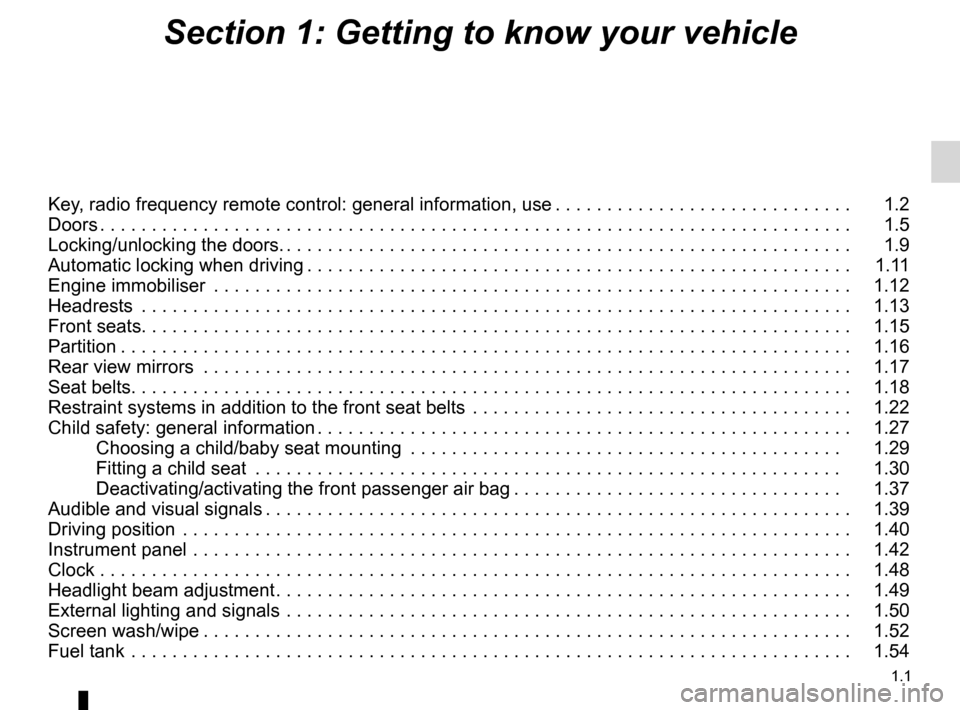
1.1
ENG_UD14018_2
Sommaire 1 (X76 - Renault)
ENG_NU_854-2_X76LL_Renault_1
Section 1: Getting to know your vehicle
Key, radio frequency remote control: general information, use . . . . . . . . . . . . . . . . . . . . . . . . . . . . . 1.2
Doors . . . . . . . . . . . . . . . . . . . . . . . . . . . . . . . . . . . . \
. . . . . . . . . . . . . . . . . . . . . . . . . . . . . . . . . . . . \
. 1.5
Locking/unlocking the doors. . . . . . . . . . . . . . . . . . . . . . . . . . . . . . . . . . . . . \
. . . . . . . . . . . . . . . . . . . 1.9
Automatic locking when driving . . . . . . . . . . . . . . . . . . . . . . . . . . . . . . . . . . . . \
. . . . . . . . . . . . . . . . . 1.1
1
Engine immobiliser . . . . . . . . . . . . . . . . . . . . . . . . . . . . . . . . . . . .\
. . . . . . . . . . . . . . . . . . . . . . . . . . 1.12
Headrests . . . . . . . . . . . . . . . . . . . . . . . . . . . . . . . . . . . .\
. . . . . . . . . . . . . . . . . . . . . . . . . . . . . . . . . 1.13
Front seats. . . . . . . . . . . . . . . . . . . . . . . . . . . . . . . . . . . . \
. . . . . . . . . . . . . . . . . . . . . . . . . . . . . . . . . 1.15
Partition . . . . . . . . . . . . . . . . . . . . . . . . . . . . . . . . . . . . \
. . . . . . . . . . . . . . . . . . . . . . . . . . . . . . . . . . . 1.16
Rear view mirrors . . . . . . . . . . . . . . . . . . . . . . . . . . . . . . . . . . . .\
. . . . . . . . . . . . . . . . . . . . . . . . . . . 1.17
Seat belts. . . . . . . . . . . . . . . . . . . . . . . . . . . . . . . . . . . . \
. . . . . . . . . . . . . . . . . . . . . . . . . . . . . . . . . . 1.18
Restraint systems in addition to the front seat belts . . . . . . . . . . . . . . . . . . . . . . . . . . . . . . . . . . . .\
. 1.22
Child safety: general information . . . . . . . . . . . . . . . . . . . . . . . . . . . . . . . . . . . . \
. . . . . . . . . . . . . . . . 1.27
Choosing a child/baby seat mounting . . . . . . . . . . . . . . . . . . . . . . . . . . . . . . . . . . . .\
. . . . . . 1.29
Fitting a child seat . . . . . . . . . . . . . . . . . . . . . . . . . . . . . . . . . . . .\
. . . . . . . . . . . . . . . . . . . . . 1.30
Deactivating/activating the front passenger air bag . . . . . . . . . . . . . . . . . . . . . . . . . . . . . . . . 1.37
Audible and visual signals . . . . . . . . . . . . . . . . . . . . . . . . . . . . . . . . . . . . \
. . . . . . . . . . . . . . . . . . . . . 1.39
Driving position . . . . . . . . . . . . . . . . . . . . . . . . . . . . . . . . . . . .\
. . . . . . . . . . . . . . . . . . . . . . . . . . . . . 1.40
Instrument panel . . . . . . . . . . . . . . . . . . . . . . . . . . . . . . . . . . . .\
. . . . . . . . . . . . . . . . . . . . . . . . . . . . 1.42
Clock . . . . . . . . . . . . . . . . . . . . . . . . . . . . . . . . . . . .\
. . . . . . . . . . . . . . . . . . . . . . . . . . . . . . . . . . . .\
. 1.48
Headlight beam adjustment . . . . . . . . . . . . . . . . . . . . . . . . . . . . . . . . . . . . \
. . . . . . . . . . . . . . . . . . . . 1.49
External lighting and signals . . . . . . . . . . . . . . . . . . . . . . . . . . . . . . . . . . . .\
. . . . . . . . . . . . . . . . . . . 1.50
Screen wash/wipe . . . . . . . . . . . . . . . . . . . . . . . . . . . . . . . . . . . . \
. . . . . . . . . . . . . . . . . . . . . . . . . . . 1.52
Fuel tank . . . . . . . . . . . . . . . . . . . . . . . . . . . . . . . . . . . .\
. . . . . . . . . . . . . . . . . . . . . . . . . . . . . . . . . . 1.54
Page 27 of 173
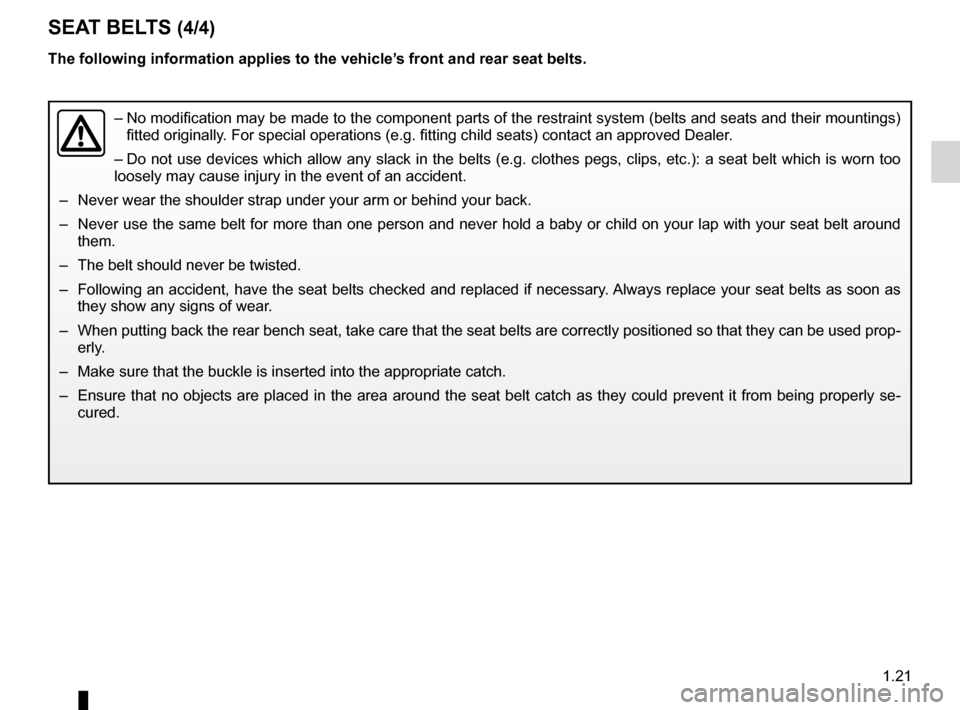
JauneNoirNoir texte
1.21
ENG_UD9537_2
Ceintures de sécurité (X76 - Renault)
ENG_NU_854-2_X76LL_Renault_1
SEAT BELTS (4/4)
– No modification may be made to the component parts of the restraint system (belts and seats and their mountings)
fitted originally. For special operations (e.g. fitting child seats) contact an approve\
d Dealer.
–
Do not use devices which allow any slack in the belts (e.g. clothes pegs, clips, etc.): a seat belt which is worn too
loosely may cause injury in the event of an accident.
–
Never wear the shoulder strap under your arm or behind your back.
– Never use the same belt for more than one person and never hold a baby or child on your lap with your seat belt around
them.
–
The belt should never be twisted.
– Following an accident, have the seat belts checked and replaced if necessary. Always replace your seat belts as soon as
they show any signs of wear.
–
When putting back the rear bench seat, take care that the seat belts are correctly positioned so that they can be used prop -
erly.
–
Make sure that the buckle is inserted into the appropriate catch.
– Ensure that no objects are placed in the area around the seat belt catch as they could prevent it from being properly se -
cured.
The following information applies to the vehicle’s front and rear seat belts.
Page 31 of 173
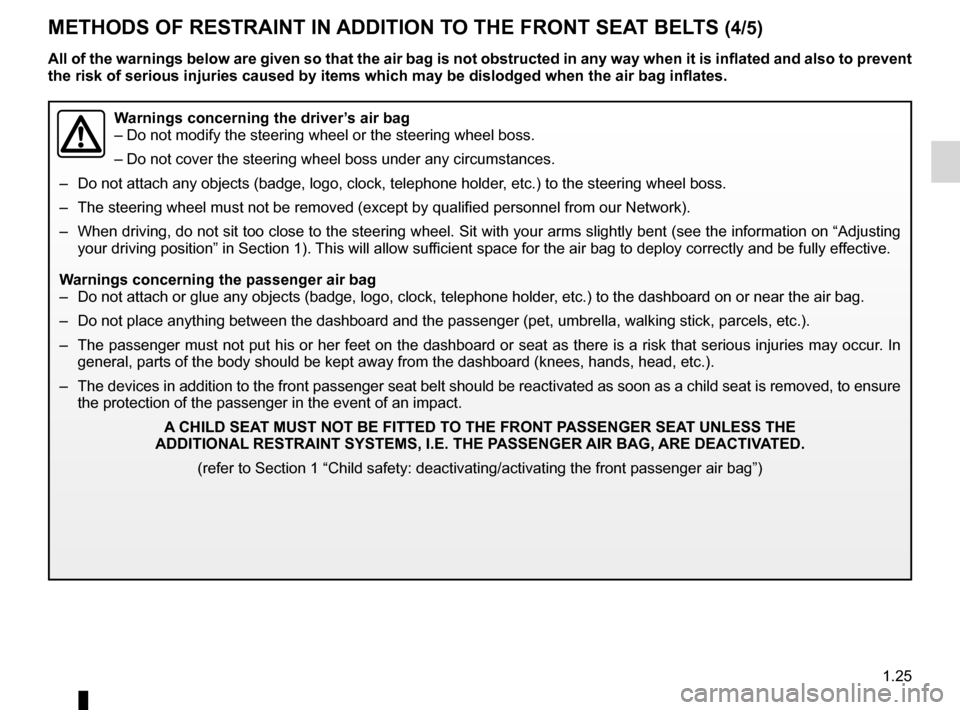
JauneNoirNoir texte
1.25
ENG_UD14673_2
Dispositifs complémentaires à la ceinture avant (X76 - Renault)
ENG_NU_854-2_X76LL_Renault_1
METHODS OF RESTRAINT IN ADDITION TO THE FRONT SEAT BELTS (4/5)
All of the warnings below are given so that the air bag is not obstructed in any way when it is inflated and also to prevent
the risk of serious injuries caused by items which may be dislodged when\
the air bag inflates.
Warnings concerning the driver’s air bag
– Do not modify the steering wheel or the steering wheel boss.
– Do not cover the steering wheel boss under any circumstances.
– Do not attach any objects (badge, logo, clock, telephone holder, etc.) to the steering wheel boss.
– The steering wheel must not be removed (except by qualified personnel from our Network).
– When driving, do not sit too close to the steering wheel. Sit with your arms slightly bent (see the information on “Adjusting
your driving position” in Section 1). This will allow sufficient space for the air bag to deploy correctly and be fully effective.
Warnings concerning the passenger air bag
–
Do not attach or glue any objects (badge, logo, clock, telephone holder, etc.) to the dashboard on or near the air bag.
– Do not place anything between the dashboard and the passenger (pet, umbrella, walking stick, parcels, etc.).
– The passenger must not put his or her feet on the dashboard or seat as there is a risk that serious injuries may occur. In
general, parts of the body should be kept away from the dashboard (knee\
s, hands, head, etc.).
–
The devices in addition to the front passenger seat belt should be reactivated as soon as a child seat is removed, to ensure
the protection of the passenger in the event of an impact.
A CHILD SEAT MUST NOT BE FITTED TO THE FRONT PASSENGER SEAT UNLESS THE
ADDITIONAL
RESTRAINT SYSTEMS, I.E. THE PASSENGER AIR BAG, ARE DEACTIv ATED.
(refer to Section 1 “Child safety: deactivating/activating the front\
passenger air bag”)
Page 33 of 173
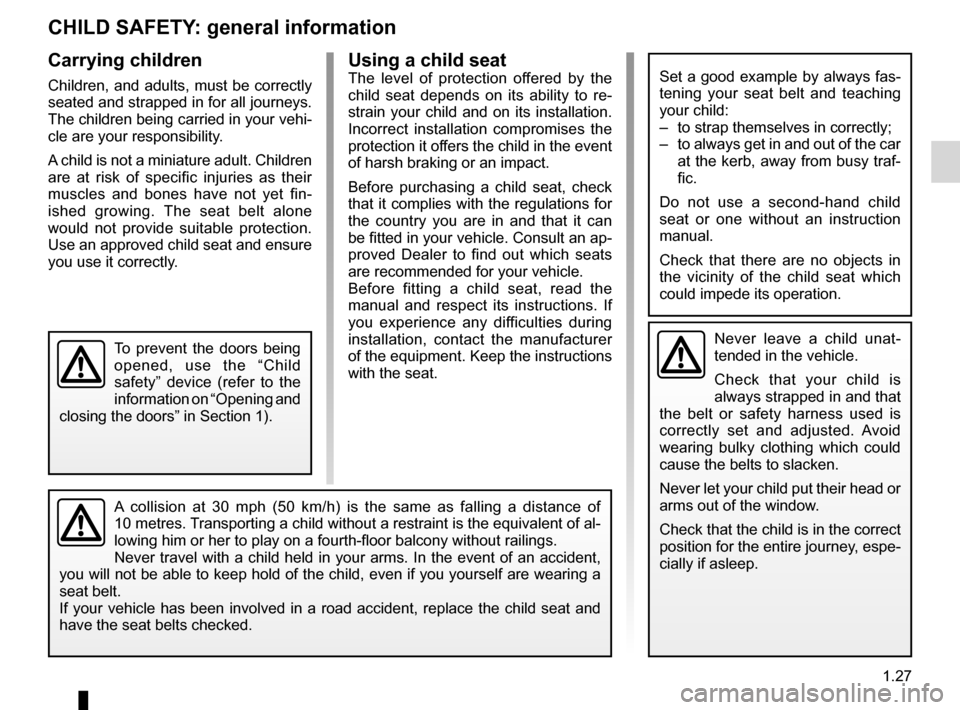
child restraint/seat ................................ (up to the end of the DU)
children ................................................. (up to the end of the DU)
child restraint/seat ................................ (up to the end of the DU)
child safety............................................ (up to the end of the DU)
child restraint/seat ................................ (up to the end of the DU)
transporting children ............................. (up to the end of the DU) 1.27
ENG_UD7697_1
Sécurité enfants : généralités (X76 - Renault)
ENG_NU_854-2_X76LL_Renault_1
Child safety: General information
CHILD SAFETY : general information
Carrying children
Children, and adults, must be correctly
seated and strapped in for all journeys.
The children being carried in your vehi-
cle are your responsibility.
A child is not a miniature adult. Children
are at risk of specific injuries as their
muscles and bones have not yet fin-
ished growing. The seat belt alone
would not provide suitable protection.
Use an approved child seat and ensure
you use it correctly.
Never leave a child unat-
tended in the vehicle.
Check that your child is
always strapped in and that
the belt or safety harness used is
correctly set and adjusted. Avoid
wearing bulky clothing which could
cause the belts to slacken.
Never let your child put their head or
arms out of the window.
Check that the child is in the correct
position for the entire journey, espe-
cially if asleep.To prevent the doors being
opened, use the “Child
safety” device (refer to the
information on “Opening and
closing the doors” in Section
1).
Set a good example by always fas-
tening your seat belt and teaching
your child:
–
to strap themselves in correctly;
– to always get in and out of the car
at the kerb, away from busy traf-
fic.
Do not use a second-hand child
seat or one without an instruction
manual.
Check that there are no objects in
the vicinity of the child seat which
could impede its operation.
A collision at 30 mph (50 km/h) is the same as falling a distance of
10
metres. Transporting a child without a restraint is the equivalent of al -
lowing him or her to play on a fourth-floor balcony without railings.
Never travel with a child held in your arms. In the event of an accident,
you will not be able to keep hold of the child, even if you yourself are wearing a
seat belt.
If your vehicle has been involved in a road accident, replace the child seat and
have the seat belts checked.
Using a child seatThe level of protection offered by the
child seat depends on its ability to re-
strain your child and on its installation.
Incorrect installation compromises the
protection it offers the child in the event
of harsh braking or an impact.
Before purchasing a child seat, check
that it complies with the regulations for
the country you are in and that it can
be fitted in your vehicle. Consult an ap-
proved Dealer to find out which seats
are recommended for your vehicle.
Before fitting a child seat, read the
manual and respect its instructions. If
you experience any difficulties during
installation, contact the manufacturer
of the equipment. Keep the instructions
with the seat.
Page 35 of 173
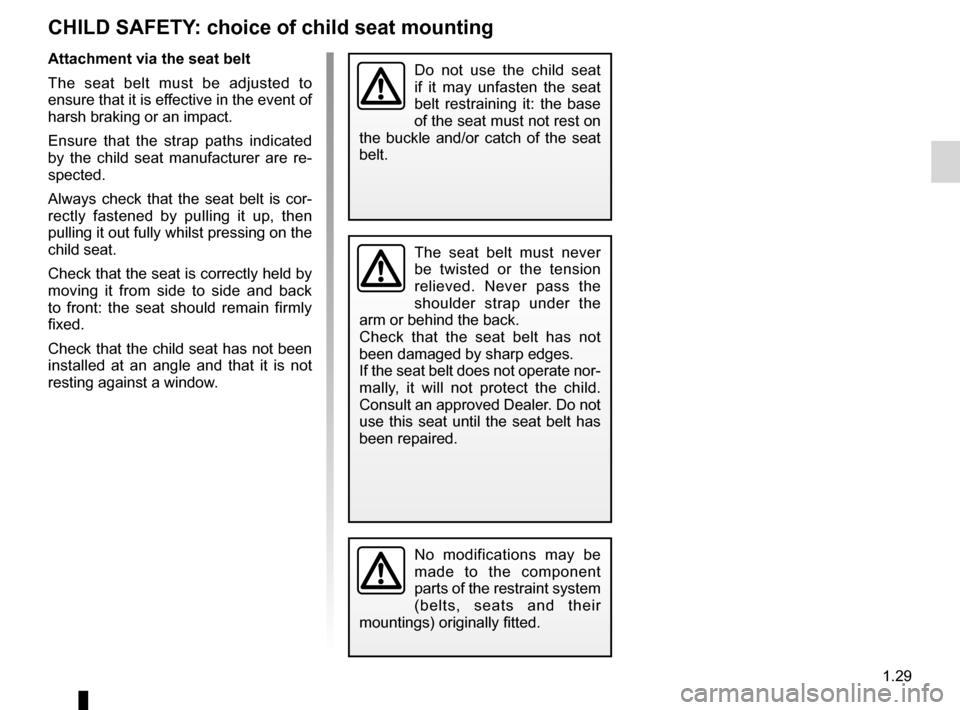
child safety............................................ (up to the end of the DU)
child restraint/seat ................................ (up to the end of the DU)
child seats............................................. (up to the end of the DU)
towing rings .......................................... (up to the end of the DU)
transporting children ............................. (up to the end of the DU)
child restraint/seat ................................ (up to the end of the DU) 1.29
ENG_UD7699_1
Sécurité enfants : choix du siège enfants (X76 - Renault)
ENG_NU_854-2_X76LL_Renault_1
Choosing a child seat mounting
CHILD SAFETY : choice of child seat mounting
Attachment via the seat belt
The seat belt must be adjusted to
ensure that it is effective in the event of
harsh braking or an impact.
Ensure that the strap paths indicated
by the child seat manufacturer are re-
spected.
Always check that the seat belt is cor-
rectly fastened by pulling it up, then
pulling it out fully whilst pressing on the
child seat.
Check that the seat is correctly held by
moving it from side to side and back
to front: the seat should remain firmly
fixed.
Check that the child seat has not been
installed at an angle and that it is not
resting against a window.
No modifications may be
made to the component
parts of the restraint system
(belts, seats and their
mountings) originally fitted.
The seat belt must never
be twisted or the tension
relieved. Never pass the
shoulder strap under the
arm or behind the back.
Check that the seat belt has not
been damaged by sharp edges.
If the seat belt does not operate nor-
mally, it will not protect the child.
Consult an approved Dealer. Do not
use this seat until the seat belt has
been repaired.
Do not use the child seat
if it may unfasten the seat
belt restraining it: the base
of the seat must not rest on
the buckle and/or catch of the seat
belt.
Page 36 of 173
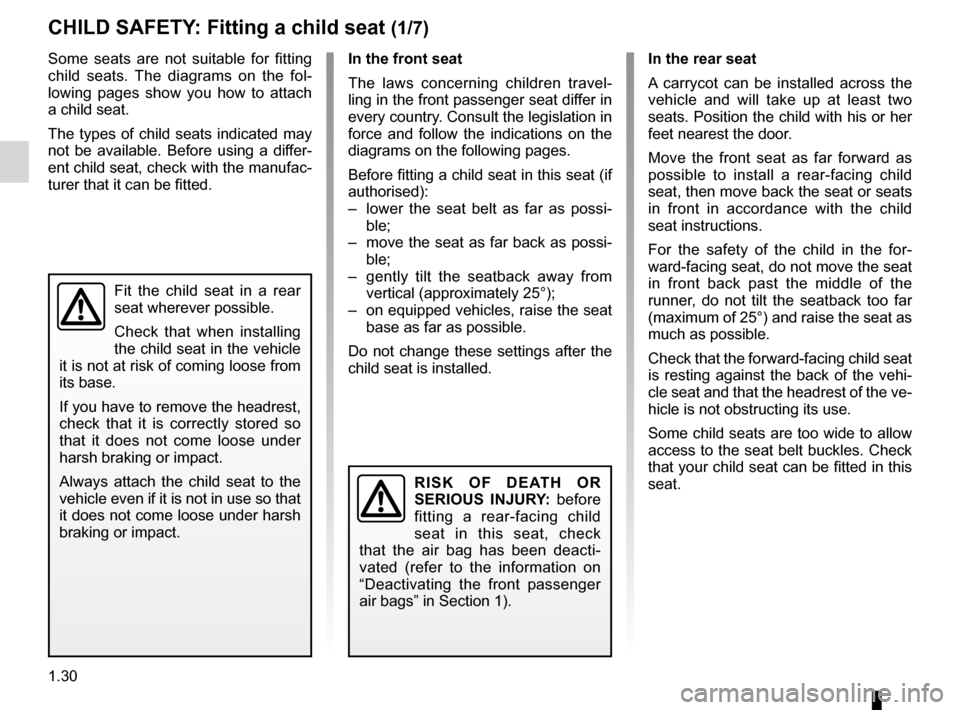
child restraint/seat ................................ (up to the end of the DU)
child restraint/seat ................................ (up to the end of the DU)
child restraint/seat ................................ (up to the end of the DU)
child safety............................................ (up to the end of the DU)
child seats............................................. (up to the end of the DU)
transporting children ............................. (up to the end of the DU)
1.30
ENG_UD14057_2
Sécurité enfants : installation du siège enfant (X76 - Renault\
)
ENG_NU_854-2_X76LL_Renault_1
Jaune NoirNoir texte
Fitting a child seat
CHILD SAFETY : Fitting a child seat (1/7)
Some seats are not suitable for fitting
child seats. The diagrams on the fol-
lowing pages show you how to attach
a child seat.
The types of child seats indicated may
not be available. Before using a differ-
ent child seat, check with the manufac-
turer that it can be fitted.
Fit the child seat in a rear
seat wherever possible.
Check that when installing
the child seat in the vehicle
it is not at risk of coming loose from
its base.
If you have to remove the headrest,
check that it is correctly stored so
that it does not come loose under
harsh braking or impact.
Always attach the child seat to the
vehicle even if it is not in use so that
it does not come loose under harsh
braking or impact.
In the front seat
The laws concerning children travel-
ling in the front passenger seat differ in
every country. Consult the legislation in
force and follow the indications on the
diagrams on the following pages.
Before fitting a child seat in this seat (if
authorised):
–
lower the seat belt as far as possi -
ble;
–
move the seat as far back as possi -
ble;
–
gently tilt the seatback away from
vertical (approximately 25°);
–
on equipped vehicles, raise the seat
base as far as possible.
Do not change these settings after the
child seat is installed. In the rear seat
A carrycot can be installed across the
vehicle and will take up at least two
seats. Position the child with his or her
feet nearest the door.
Move the front seat as far forward as
possible to install a rear-facing child
seat, then move back the seat or seats
in front in accordance with the child
seat instructions.
For the safety of the child in the for-
ward-facing seat, do not move the seat
in front back past the middle of the
runner, do not tilt the seatback too far
(maximum of 25°) and raise the seat as
much as possible.
Check that the forward-facing child seat
is resting against the back of the vehi-
cle seat and that the headrest of the ve-
hicle is not obstructing its use.
Some child seats are too wide to allow
access to the seat belt buckles. Check
that your child seat can be fitted in this
seat.
R I S K O F D E AT H O R
SERIOUS INJURY:
before
fitting a rear-facing child
seat in this seat, check
that the air bag has been deacti-
vated (refer to the information on
“Deactivating the front passenger
air bags” in Section 1).
Page 43 of 173
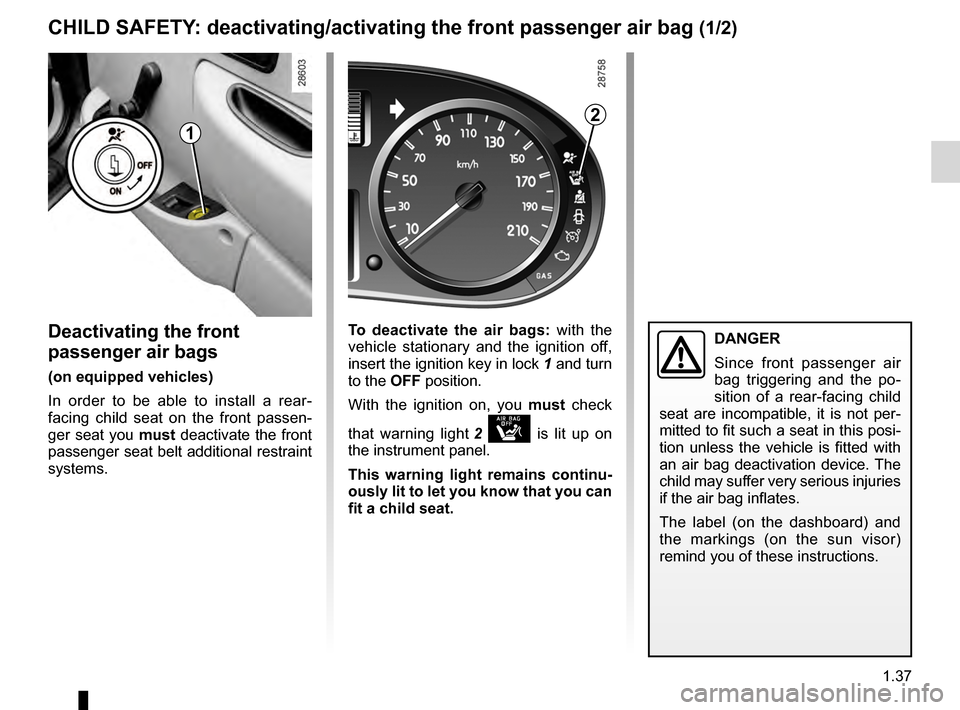
child safety............................................ (up to the end of the DU)
transporting children ............................. (up to the end of the DU)
child restraint/seat ................................ (up to the end of the DU)
child restraint/seat ................................ (up to the end of the DU)
air bag deactivating the front passenger air bags ........ (current page)
front passenger air bag deactivation ..................... (current page) 1.37
ENG_UD8776_1
Sécurité enfants : désactivation/Activation airbag passager (X\
76 - Renault)
ENG_NU_854-2_X76LL_Renault_1
Deactivating/activating the front passenger air bag
CHILD SAFETY : deactivating/activating the front passenger air bag (1/2)
Deactivating the front
passenger air bags
(on equipped vehicles)
In order to be able to install a rear-
facing child seat on the front passen-
ger seat you must deactivate the front
passenger seat belt additional restraint
systems. To deactivate the air bags:
with the
vehicle stationary and the ignition off,
insert
the ignition key in lock 1 and turn
to the OFF position.
With the ignition on, you must check
t
hat warning light 2
ã is lit up on
the instrument panel.
This warning light remains continu-
ously lit to let you know that you can
fit a child seat.
DANGER
Since front passenger air
bag triggering and the po-
sition of a rear-facing child
seat are incompatible, it is not per-
mitted to fit such a seat in this posi-
tion unless the vehicle is fitted with
an air bag deactivation device. The
child may suffer very serious injuries
if the air bag inflates.
The label (on the dashboard) and
the markings (on the sun visor)
remind you of these instructions.
2
1
Page 44 of 173
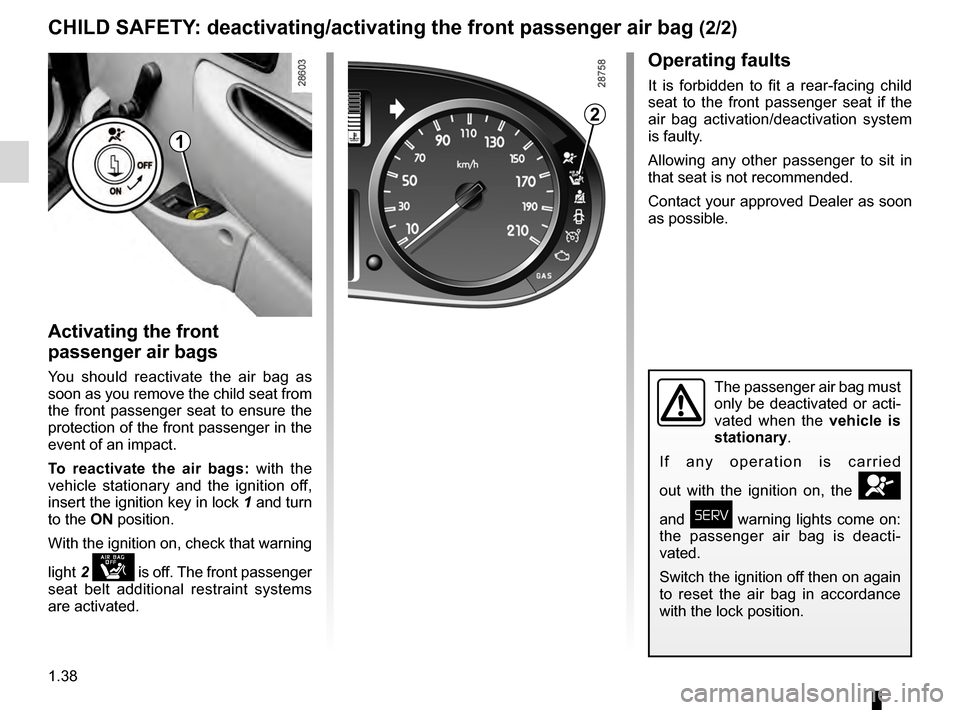
air bagactivating the front passenger air bags ............ (current page)
1.38
ENG_UD8776_1
Sécurité enfants : désactivation/Activation airbag passager (X\
76 - Renault)
ENG_NU_854-2_X76LL_Renault_1
CHILD SAFETY : deactivating/activating the front passenger air bag (2/2)
Activating the front
passenger air bags
You should reactivate the air bag as
soon as you remove the child seat from
the front passenger seat to ensure the
protection of the front passenger in the
event of an impact.
To reactivate the air bags: with the
vehicle stationary and the ignition off,
insert
the ignition key in lock 1 and turn
to the ON position.
With the ignition on, check that warning
light
2
ã is off. The front passenger
seat belt additional restraint systems
are activated.
The passenger air bag must
only be deactivated or acti-
vated when the vehicle is
stationary.
I f a n y o p e r a t i o n i s c a r r i e d
out with the ignition on, the
å
and
ø warning lights come on:
the passenger air bag is deacti-
vated.
Switch the ignition off then on again
to reset the air bag in accordance
with the lock position.
Operating faults
It is forbidden to fit a rear-facing child
seat to the front passenger seat if the
air bag activation/deactivation system
is faulty.
Allowing any other passenger to sit in
that seat is not recommended.
Contact your approved Dealer as soon
as possible.
2
1
Page 169 of 173

7.1
FRA_UD14024_2
Index (X76 - Renault)
ENG_NU_854-2_X76LL_Renault_7
D
dipstick................................................................\
........ 4.3 – 4.4
doors........................................................................\
1.5 → 1.11
driving ........................................................................\
.......... 2.4
E
electric windows ..................................................... 3.14
– 3.15
emergency brake assist..................................................... 2.12
emergency braking ............................................................ 2.12
emergency spare wheel ...................................................... 5.2
engine technical specifications .................................................. 6.4
engine immobiliser......................................................\
....... 1.12 system ........................................................................\
. 1.12
engine oil ................................................................... 4.3 → 4.6
engine oil level ........................................................... 4.3 → 4.6
engine specifications ........................................................... 6.4
environment ........................................................................\
. 2.9
F
filter diesel filter .................................................................... 5.32
fitting a radio ...................................................................... 5.28
fog lights ........................................................................\
.... 5.10
front lights changing bulbs ...................................................... 5.8
– 5.9
front passenger air bag deactivation ................................. 1.37
front seats adjustment ................................................................... 1.15
fuel advice on fuel economy .......................................2.6 → 2.8
fuel economy ............................................................. 2.6 → 2.8
fuel filler cap ........................................................... 1.54
– 1.55
fuel tank capacity ............................................................. 1.54
– 1.55
fuel tank capacity .................................................... 1.54 – 1.55
A
ABS
........................................................................\
........... 2.11
accessories.............................................................\
........... 5.29
advice on antipollution ............................................... 2.6 → 2.8
air bag.................................................................... 1.22 → 1.26
activating the front passenger air bags ........................ 1.38
deactivating the front passenger air bags .................... 1.37
air conditioning ........................................................ 3.7 → 3.11
air vents ...................................................................... 3.2
– 3.3
anti-corrosion check .............................................. 6.15 → 6.20
anti-corrosion protection .................................................... 4.11
anti-lock braking system: ABS ........................................... 2.11
antipollution advice .................................................................. 2.6 → 2.8
ashtrays ........................................................................\
..... 3.16
audible and visual signals.................................................. 1.39
B
battery troubleshooting ................................................. 5.19
– 5.20
bonnet........................................................................\
.......... 4.2
bulbs changing ...................................... 5.8 → 5.10,
5.14 → 5.18
C
catalytic converter................................................................ 2.4
changing a bulb .......................... 5.4,
5.8 → 5.10, 5.14 → 5.18
child restraint/seat ................................................. 1.27 → 1.38
child safety............................... 1.2,
1.6, 1.27 → 1.38, 2.3, 3.14
child seats.............................................................. 1.29 → 1.36
children ............................................ 1.2,
1.6, 1.27 – 1.28, 3.14
cigar lighter ........................................................................\
3.16
clock ........................................................................\
.......... 1.48
control instruments ................................................ 1.42 → 1.45
courtesy light ..................................................................... 3.12
courtesy mirrors ................................................................. 3.13
AlphABEtiCAl inDEx (1/2)